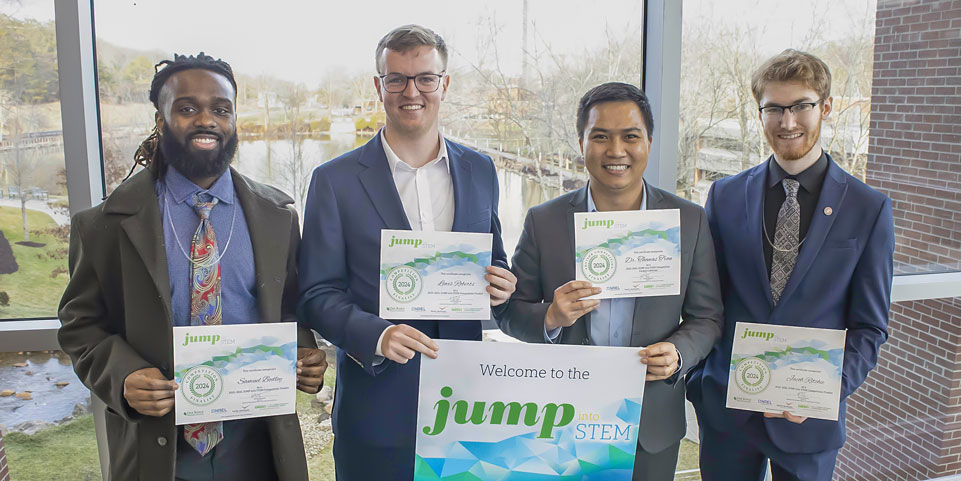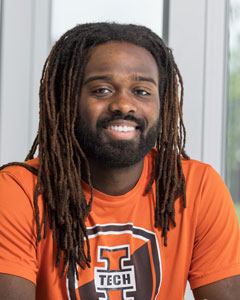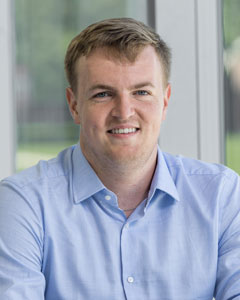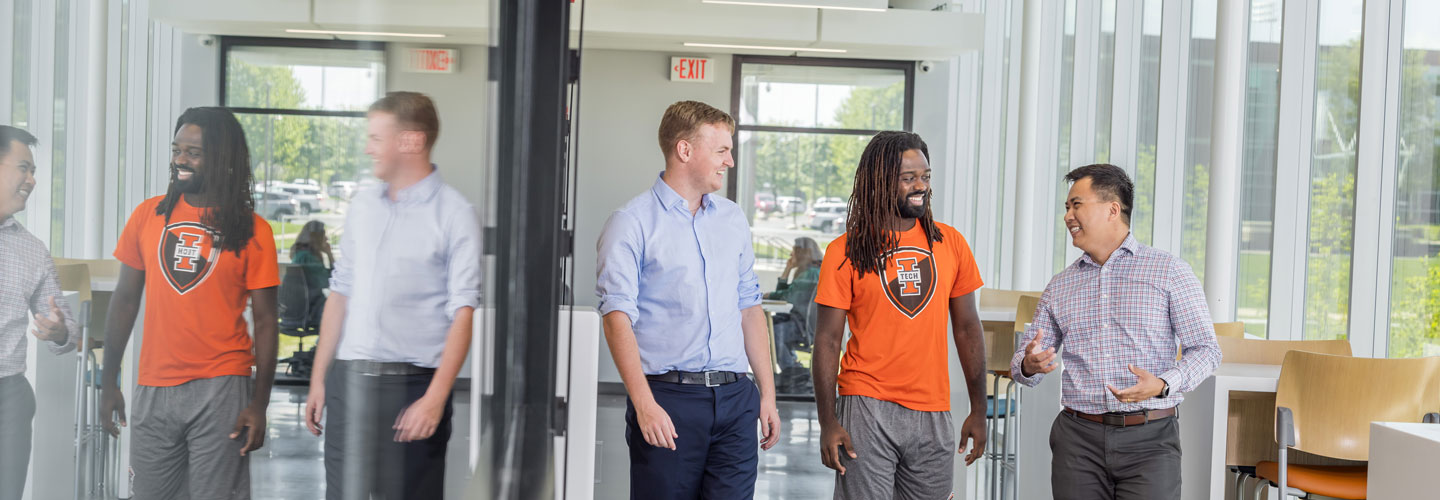Concrete ideas about reducing emissions
By Julianne Will
Unless you’re an engineer, architect or builder, you probably don’t spend a lot of time thinking about concrete.
It’s just there, largely under foot or integrated into a larger structure, the whole of which you usually consider far more than its parts.
So you might not know that concrete production and use is one of the leading causes of global CO2 emissions, coming in at about 8 percent worldwide. It contributes far more CO2 globally than aviation fuel (at roughly 2.5 percent). If the concrete industry were a country, it would be the fourth largest emitter in the world, behind only China, India and the United States.
But a team of Indiana Institute of Technology students knows all of this and more. Further, they have ideas about how to address it.
The trio researched this major global problem alongside other world-class scholars aiming to solve thermodynamics challenges during the annual JUMP (Join the discussion, Unveil innovation, Make connections, Promote tech-to-market) into STEM building science competition.
The caliber of fellow competitors was high, including doctoral candidates and other students from engineering powerhouses such as Embry-Riddle Aeronautical University, University of Nebraska-Lincoln, North Carolina Agricultural and Technical State University, Purdue University, University of North Carolina at Charlotte and Worcester Polytechnic Institute.

That didn’t stop the Indiana Tech team from securing a solid showing at the Oak Ridge National Laboratory in Oak Ridge, Tennessee. Jacob Ritchie and Lewis Roberts, part of the team tackling the concrete problem, paved a path all the way to the final round of the competition.
They weren’t alone: Senior Samuel Bodley reached the final round with his team’s green roof building solutions. Sam’s team was brainstorming topics when he came across the application of green roofs in Asia, where they’re growing rapidly — literally and figuratively — on new and existing development.

The team liked the idea of making cities green not only numerically, by capturing carbon and moderating the temperature of the building, but also visually, imbuing urban spaces with the hue of the plants and trees that make up a green roof. Their proposed solution includes tax benefits for the construction of green roofs and specialized training for industry professionals.
Sam also took top honors in the Elevator Pitch challenge at the competition.
“It was an outstanding accomplishment for the students,” says Dr. Thomas Tran, Indiana Tech assistant professor of mechanical engineering.
Students participated in the JUMP into STEM competition as a class project in Dr. Tran’s ME 4200 — Thermal Science Investigations course in the fall of 2023. They were tasked with identifying innovative solutions within challenge topics, such as “Keeping it Cool (Or Hot),” focusing on thermal energy storage for buildings to optimize energy utilization, enhance sustainability and increase resilience; or “You and Me, Carbon Free,” reducing carbon emissions from U.S. buildings (residential or commercial, new or existing).
Students’ problem statements were required to address embodied carbon emissions and/or operational carbon emissions. Their response had to lead to significant reductions in carbon emissions and increased affordability for stakeholders.
Overall, Dr. Tran’s class fielded six teams. Senior mechanical engineering students Lewis and Jacob along with Marley Jackson formed the Concrete Evolution team to assess methods of carbon dioxide recycling and injection during concrete manufacturing, reducing carbon emissions while maintaining the integrity of concrete properties.
And Sam worked with fellow senior mechanical engineering students and Eco Skyline team members Tobias Machourek and Nathan Boyleaims to identify ways to grow the number of green roofs (vegetated systems installed on building rooftops) sprouting in major cities to counteract mass carbon emissions.
While all of the students took part in their teams’ research to explore solutions and draft papers on their topics, only those who applied to land a paid summer internship could take part in the JUMP into STEM competition in Tennessee.
Sending two teams to the finals from Indiana Tech becomes even more impressive when you consider that just nine teams are selected from the 60 to 80 who enter nationwide.
This is the second year that Dr. Tran’s students have participated in JUMP into STEM. It’s also the second year that his students have been selected for internships at U.S. Department of Energy national laboratories. Last year, Kennedy Moonin, Lindsey Albrecht, Jacob Frogge and Dante Siracusa, all senior mechanical engineering students, formed the Repurpose EV Batteries team with the aim of upcycling old electric vehicle battery modules for backup power systems, targeting rural communities or communities with uncertain power supplies. They won first place in the It’s Electric challenge.
During the final competition, participants present their JUMP into STEM submissions to a panel of judges, learn about career paths in building science, network with experts in the field, tour the national lab and more.
The chance to test their chops against the top young researchers in the country is no small opportunity for Dr. Tran’s students. “It’s a different kind of knowledge they have right now compared to the graduate students,” he says. Clearly, however, they’re prepared to take the heat in the thermodynamics field.
Sam was surprised by what he learned not only about capturing carbon, but also about himself. “I think what impacted me most is really learning something about how to benefit the world,” Sam says. “They were showing me a lot of things that I wasn’t really thinking about.
“At first I was thinking mostly about the automotive field, but it opened my eyes to realize that you need to just branch out and look at a lot of different paths before you actually know what you want to do. I really liked that a lot. They’re teaching me a lot about what we learned in our classes and how they actually apply to the real world.”

“It’s just quite a unique experience,” says Lewis of the JUMP into STEM competition. “Not many people get to go to a national lab where loads of research is done and where basically the experts of the field are doing research. Getting to see that whole environment just is quite a unique experience that not many people can get.”
It also expanded his potential avenues for a career. “At first I just didn’t really know which sector I wanted to go in. Obviously, I had topics that I really liked in tech or thermodynamics,” Lewis says. “But then going through this competition, I realized how big of a thing needs to be done to change how we do things now and technologies that we need to reduce CO2 emissions and global warming before its devastating impact around the world. So this has really changed my mind about what I want to do.”
While the Indiana Tech competitors weren’t challenge winners this year, they so impressed the judges that each is being offered the chance to intern at one of the national laboratories. That will certainly cement, so to speak, their network of supporters and colleagues as they venture into the work world.
“The people there — honestly, it was kind of unreal,” Sam says. “Everybody always had a smile on their face. They knew that they were just doing something that helped (the environment) on such a big scale, and the connections were amazing. I already went on LinkedIn and connected with a lot of people there, and a lot of them were saying they could help me with anything I needed if I got in touch.”
“When we got picked to go to the finals, that got my interest piqued,” Lewis says. “Then I did a bit more research about the national lab and what they do. And then while we were there, it was amazing, because we got a tour of some places. The people we met — everyone was so friendly. It was like they were there to support you and make sure you did the best you could. So it was a good experience to have.”
About JUMP into STEM
The JUMP into STEM program is a building sciences competition for undergraduate and graduate students at U.S. colleges and universities. It began as a crowdsourcing community launched by Oak Ridge National Laboratory in 2015 and now aims to attract bright students from a variety of majors to building science via annual challenges. Funded by the Department of Energy, it’s jointly run by the National Renewable Energy Laboratory and Oak Ridge National Laboratory.
Team submissions are evaluated for technical potential, innovation, diversity and applicability. JUMP into STEM awards one winner from each of three challenge topics.
Challenge winners and additional teams are invited to compete in the JUMP into STEM Final Competition. Final competition winners receive a 10-week paid summer internship at the National Renewable Energy Laboratory, Oak Ridge National Laboratory or Pacific Northwest National Laboratory.
